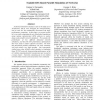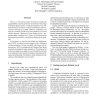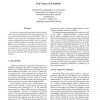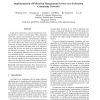PADS
2003
ACM
14 years 8 months ago
2003
ACM
We describe two major developments in the General Network Simulation Integration System (Genesis): the support for BGP protocol in large network simulations and distribution of th...
PADS
2003
ACM
14 years 8 months ago
2003
ACM
In distributed simulations, such as multi-player distributed virtual environments (DVE), power consumption traditionally has not been a major design factor. However, emerging batt...
PADS
2003
ACM
14 years 8 months ago
2003
ACM
This paper presents Maya, a multi-paradigm, scalable and extensible network modeling framework for emulating distributed applications. A novel three-tier architecture is proposed ...
PADS
2003
ACM
14 years 8 months ago
2003
ACM
PADS
2003
ACM
14 years 8 months ago
2003
ACM
The simulation of large–scale multicast networks often requires a significant amount of memory that can easily exceed the capacity of current computers, both because of the inh...
PADS
2003
ACM
14 years 8 months ago
2003
ACM
Federated simulation interfaces such as the High Level Architecture (HLA) were designed for interoperability, and as such are not traditionally associated with highperformance com...
PADS
2003
ACM
14 years 8 months ago
2003
ACM
There is a wide-spread usage of hardware design languages(HDL) to speed up the time-to-market for the design of modern digital systems. Verification engineers can simulate hardwa...
PADS
2003
ACM
14 years 8 months ago
2003
ACM
We present a classification that groups lookback into four types: direct strong lookback, universal strong lookback, direct weak lookback, and universal weak lookback. They are d...
PADS
2003
ACM
14 years 8 months ago
2003
ACM
Packet-level discrete-event network simulators use an event to model the movement of each packet in the network. This results in accurate models, but requires that many events are...
PADS
2003
ACM
14 years 8 months ago
2003
ACM
A federation community is a group of federations working together to achieve a common goal. With a federation community, a large-scale simulation can be built using existing simul...




